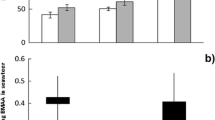Abstract
The uptake and metabolism of 14C-L-leucine by Cystoclonium purpureum (Huds) Batt. (Rhodophyllidaceae) at concentrations of 0.5–50 μM were studied. Leucine was taken up from seawater at rates of 10–160 nmol·g-1 fresh weight·h-1. At low leucine levels ( 5 μM) the amino acid was preferably incorporated into cellular protein; amine formation was less than 5%. However at leucine concentrations of 50 μM, more than 30% of the total leucine taken up was decarboxylated to 3-methylbutylamine. This effect is expressed even more in Dumontia increassata (O. F. Müll) Lamour. (Dumontiaceae). In both species some of the amine occurred as a non-volatile derivative (bound amine) from which free amine could quantitatively be released by acid hydrolysis. Leucine and amine uptake were inhibited by CCCP. However, from cells preloaded with both leucine and amine, only free amine is released in the presence of CCCP. The results indicate that decarboxylase activity will be switched on at increased levels of amino acids in seawater which may be expected frequently in habitats of littoral algae (tidal zone). A possible function of amine formation and release within the scope of chemical defence of benthic algae is discussed.
Similar content being viewed by others
Literature cited
Aufermann, B.: Zur Chemotaxonomie mariner Rhodophyceen. Bib. Phycol. 43, 1–136 (1978)
Bohling, H.: Untersuchungen über freie gelöste Aminosäuren im Meerwasser. Mar. Biol. 6, 213–225 (1970)
Bohling, H.: Gelöste Aminosäuren im Oberflächenwasser der Nordsee bei Helgoland: Konzentrationsänderungen im Sommer 1970. Mar. Biol. 16, 281–289 (1972)
Chau, Y. K. and J. P. Riley: The determination of amino acids in seawater. Deep Sea Res. 13, 1115–1124 (1966)
Clark, M. E., G. A. Jackson and K. N. F. Shaw: Dissolved free amino acids in southern California coastal waters. Limnol. Oceanogr. 17, 749–758 (1972)
Eschrich, W. and T. Hartmann: Translokation und biochemisches Verhalten von D- und L-Phenylalanin bei Vicia faba. Planta 85, 213–227 (1969)
Guggenheim, M.: Die biogenen Amine der Pflanzenwelt. Handb. Pflanzenphysiol. 8, 889–988 (1958)
Hartmann, T.: Methode zur quantitativen Trennung und Bestimmung flüchtiger pflanzlicher Amine. Planta 65, 315–333 (1965)
Hartmann, T.: Leucin-Carboxylyase aus marinen Rhodophyceae: Vorkommen, Verbreitung und einige Eigenschaften. Phytochem. 11, 1327–1336 (1972a)
Hartmann, T.: Leucin-Carboxylase aus marinen Rhodophyceae: Eigenschaften des Enzyms aus Polysiphonia urceolata. Biochem. Physiol. Pflanz. 163, 1–13 (1972b)
Hartmann, T.: Leucin-Carboxylyase aus marinen Rhodophyceae: Coenzymspezifität und Aktivierung durch Carbonylver-bindungen. Biochem. Physiol. Pflanz. 163, 14–29 (1972c)
Hartmann, T. and B. Aufermann: Zur Physiologie der Aminbildung bei der marinen Rotalge Polysiphonia urceolata. Mar. Biol. 21, 70–74 (1973)
Hartmann, T., K. Bax and R. Scholz: Aliphytic L-amino acid decarboxylase from ferns (Filicopsida). Z. Naturforschung (In press)
Hoppe, H. A., T. Levring and Y. Tanaka (eds.): Marine algae in pharmaceutical science, 807 pp. Berlin, New York: De Gruyter 1979
Iiert, H.-I. and T. Hartmann: Dünnschichtchromatographie der 2,4-Dinitrophenylderivate wasserdampfflüchtiger Amine und ihre Anwendung auf die Trennung pflanzlicher Amine. J. Chromatogr. 71, 119–125 (1972)
Kneifel, H.: Amines in algae. In: Marine algae in pharmaceutical science, pp 366–401. Ed. by H. A. Hoppe. Berlin, New York: De Gruyter 1979
Smith, M. M. and K. R. Gayler: Free amino acids in the marine alga Caulerpa simpliciuscula. Bot. Mar. 22, 361–365 (1979)
Schmitz, K. and W. Riffarth: Carrier-mediated uptake of L-leucine by the brown alga Giffordia mitchellae. Z. Pflanzenphysiol. 96, 311–324 (1980)
Steiner, M. and T. Hartmann: Über Vorkommen und Verbreitung flüchtiger Amine bei Meeresalgen. Planta 79, 113–121 (1968)
Wheeler, P. A., B. B. North and G. C. Stephens: Amino acid uptake by marine phytoplankters. Limnol. Oceanogr. 19, 249–259 (1974)
Wheeler, P. A., M. Littler and G. C. Stephens: Uptake of glycine by natural phytoplankton communities. Limnol. Oceanogr. 22, 900–910 (1977)
Author information
Authors and Affiliations
Additional information
Communicated by O. Kinne, Hamburg
Rights and permissions
About this article
Cite this article
Hartmann, T., Löhr, E. Decarboxylation of environmental L-leucine by marine red algae. Mar. Biol. 78, 7–12 (1983). https://doi.org/10.1007/BF00392965
Accepted:
Issue Date:
DOI: https://doi.org/10.1007/BF00392965



